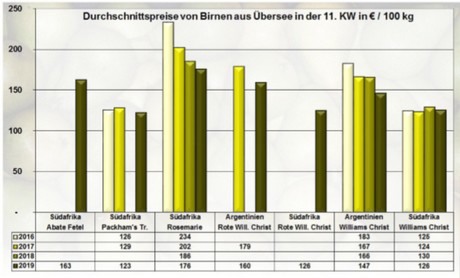Italian pears of the Abate Fetel and Santa Maria varieties, whose quality continued to be good, could still be accessed and their prices then solidified. From Europe came also Dutch, Belgian and German Conference as well as Italian Williams Christ and Dutch Alexander Lucas. Doyenne du Comice from France and the Netherlands cost only €0.75 to 1,- per kg in Berlin. Turkish Santa Marias were available in Frankfurt and Hamburg.

Supplies from overseas continued to become available. South African imports played a central role: The basis of these offers were Rosemarie and Williams Christ; The latter suffered already experienced some in the markets of Hamburg. The presence of Abate Fetel, completing the ranges, grew and Packham's triumph also gained in importance. From Chile there came Vereinsdechant pears, which in Frankfurt went up to €25.50 per 8 kg but rarely got any attention. Argentinian Williams Christ and Red Bartlett had a rather complementary character. Overall, the markets went on without any special highlights. Locally, small fruits cleared up quickly. The prices showed no specific direction in any way: they went both up and down.
Apples
Availability did not change significantly; there was enough produce to satisfy the constant demand. The prices were mostly at the current level.
Table grapes
South Africa dominated events with Thompson Seedless, Crimson Seedless and Flame Seedless. As their organoleptic properties were very good, the sellers could uphold their prices.
Oranges
Mainly, juice oranges were in demand. The influxes of Spanish Navelina abruptly stopped as there were only very few supplies left. Lane Lates from Spain were well received and got rather expensive now and then.
Small citrus fruits
Israeli Orri were dominant on the market here, much more so than Spanish Orri and Nadorcott. The shipments coming in from Morocco and Turkey were rather limited; their quality very often left something to be desired.
Lemons
Spanish Primofiori determined the scenery. Turkish shipments supplemented the market, but their importance was limited. The sales slowed down; this was especially so for the marketing of the Spanish batches.
Bananas
The scope of the supply hardly saw any change. It generally remained well-dosed, but usually correlated with any sales opportunities.
Cauliflower
Although availability was limited, it was not always possible to empty the warehouses. The prices therefore often tended to go downwards.
Lettuce
With regard to ice berg lettuce, only Spanish supplies could be accessed. Supply and demand were roughly balanced out. Nevertheless, prices often showed a downward trend.
Cucumbers
Cucumbers from the Netherlands dominated the market, some way ahead of the products from Spain and Belgium. The supplies expanded and were quite sufficient to meet the demand. The prices developed variably.
Tomatoes
The availability of shipments from the Netherlands grew, while the presence of Spanish and Italian was somewhat limited. The demand could be satisfied without any problems.
Sweet peppers
Spain dominated the market before Turkey, the Netherlands, Morocco and Belgium. The onset of winter in the growing areas noticeably reduced Turkish imports, causing the prices of the peppers to rise.
